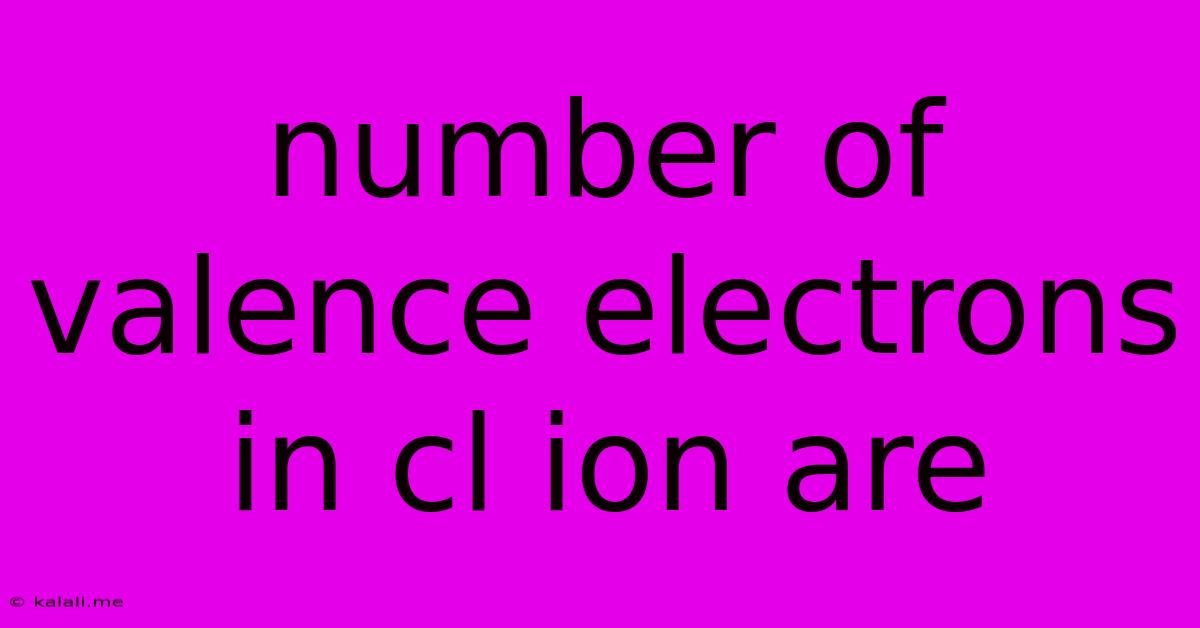Number Of Valence Electrons In Cl Ion Are
Kalali
Jun 16, 2025 · 2 min read

Table of Contents
The Number of Valence Electrons in a Chloride Ion (Cl⁻)
The number of valence electrons in a chloride ion (Cl⁻) is a fundamental concept in chemistry. Understanding this helps us grasp its reactivity and bonding behavior. This article will explain how to determine the number of valence electrons in a chloride ion, detailing the process and its significance. It will also cover related concepts to provide a comprehensive understanding.
What are Valence Electrons?
Valence electrons are the electrons located in the outermost shell (or energy level) of an atom. These electrons are crucial because they participate in chemical bonding with other atoms. The number of valence electrons determines an element's reactivity and the types of bonds it can form. Atoms tend to gain, lose, or share valence electrons to achieve a stable electron configuration, often resembling that of a noble gas.
Determining Valence Electrons in Chlorine (Cl)
Chlorine (Cl) is a nonmetal in Group 17 (also known as Group VIIA or the halogens) of the periodic table. Its atomic number is 17, meaning it has 17 protons and 17 electrons in a neutral atom. The electron configuration of a neutral chlorine atom is 2, 8, 7. This means it has:
- 2 electrons in the first energy level (shell)
- 8 electrons in the second energy level
- 7 electrons in the third energy level (valence shell)
Therefore, a neutral chlorine atom has 7 valence electrons.
Formation of the Chloride Ion (Cl⁻)
Chlorine readily gains one electron to achieve a stable octet (8 electrons) in its outermost shell, mimicking the electron configuration of the noble gas argon (Ar). This process forms a negatively charged ion called a chloride ion (Cl⁻).
Valence Electrons in the Chloride Ion
When chlorine gains an electron to become a chloride ion, the additional electron fills the third energy level, completing the octet. The electron configuration of Cl⁻ becomes 2, 8, 8. Therefore, the chloride ion has 8 valence electrons.
Significance of the Octet Rule
The octet rule is a guideline stating that atoms tend to gain, lose, or share electrons to achieve a full set of eight valence electrons. This stable configuration minimizes their energy and increases their stability. The formation of the chloride ion perfectly exemplifies this rule.
In Summary:
- A neutral chlorine atom has 7 valence electrons.
- A chloride ion (Cl⁻) has 8 valence electrons.
- The gain of one electron allows chlorine to achieve a stable octet configuration, fulfilling the octet rule.
- Understanding valence electrons is essential for predicting the chemical behavior and bonding properties of elements and ions.
This knowledge is crucial for comprehending chemical reactions, ionic bonding, and the properties of ionic compounds. Further study of chemical bonding and electron configurations will provide a deeper understanding of these concepts.
Latest Posts
Latest Posts
-
Friction Factor Formula For Laminar Flow
Jun 16, 2025
-
Select The True Statements About Sending Information On The Internet
Jun 16, 2025
-
List The Criteria For Effective Taxes
Jun 16, 2025
-
Electric Field Inside Non Conducting Sphere
Jun 16, 2025
-
The Kilowatt Is A Unit Of
Jun 16, 2025
Related Post
Thank you for visiting our website which covers about Number Of Valence Electrons In Cl Ion Are . We hope the information provided has been useful to you. Feel free to contact us if you have any questions or need further assistance. See you next time and don't miss to bookmark.